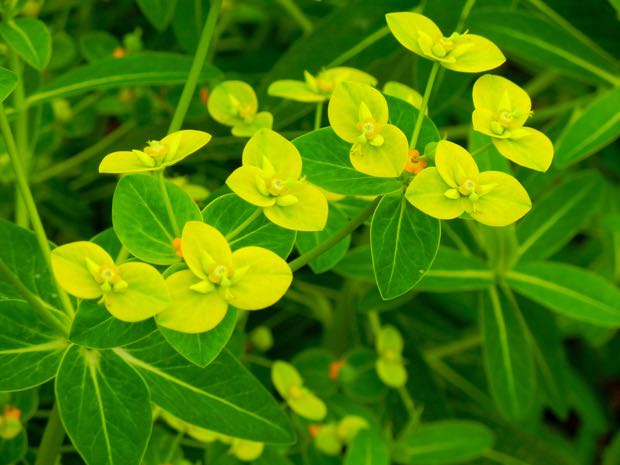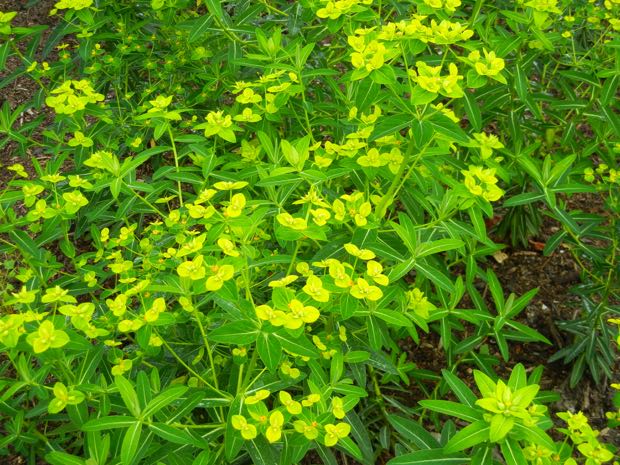Euphorbia schillingii – A Hardy Perennial with Vibrant Flowers
Euphorbia schillingii, also known as Schilling Spurge, is a herbaceous perennial that adds beauty and interest to any garden. It belongs to the Euphorbiaceae family and is native to the Himalayas in Nepal. This plant is named after Tony Schilling, a renowned plant hunter.
Description and Growing Conditions
Euphorbia schillingii features erect leafy stems with narrow, deep green leaves that have prominent white mid-ribs. The plant forms broad terminal clusters of bright yellow flowers, which add a vibrant touch to the garden. It typically grows to a height of 1 meter (3.3 feet) and spreads about 0.5 meters (1.6 feet) wide.
This perennial thrives in moist, well-drained soil and prefers partial shade locations. It is highly adaptable and can tolerate temperatures as low as -15°C (5°F). Euphorbia schillingii can be propagated through seed or division.
Care and Maintenance of Euphorbia schillingii:
Caring for Euphorbia schillingii is relatively straightforward, as this hardy perennial requires minimal maintenance. Here are some additional details on how to care for and maintain this beautiful plant:
Watering: Euphorbia schillingii appreciates regular watering, especially during the first year after planting when it is establishing its root system. Ensure that the soil is consistently moist but not waterlogged. Once the plant is established, it becomes more drought-tolerant but will still benefit from regular watering during hot and dry periods. Deep watering is essential to ensure that the water reaches the plant’s roots. Allow the soil to dry out slightly between waterings to prevent overwatering.
Fertilizing: Euphorbia schillingii generally does not require frequent fertilization. However, providing a light application of fertilizer once a year in the spring can help promote healthy growth and abundant blooms. Choose a balanced fertilizer with an equal ratio of nitrogen, phosphorus, and potassium (such as 10-10-10) and follow the manufacturer’s instructions for application rates.
Pests and Diseases: Euphorbia schillingii is generally resistant to pests and diseases. However, like many plants, it may occasionally encounter issues such as aphids, mealybugs, or scale insects. If you notice any signs of infestation, it’s essential to address them promptly to prevent further damage. You can use insecticidal soap or neem oil, following the product instructions, to control these pests. Regularly inspect the plant for any signs of disease, such as leaf spots or wilting, and take appropriate measures if necessary.
Cutting Back:
In the fall, after Euphorbia schillingii has finished blooming, you can cut back the plant to the ground. This practice helps tidy up the garden and prepares the plant for the dormant winter period. By cutting back the stems, you remove any dead or dying foliage, reducing the risk of disease and pest issues. It’s important to dispose of the cuttings properly, as the milky sap of Euphorbia species can cause skin irritation.
Deadheading: Regular deadheading is beneficial for Euphorbia schillingii as it encourages the plant to produce more blooms and extends the flowering period. To deadhead, simply pinch off the spent flower heads at the base using your fingers or small pruning shears. Removing the faded flowers not only improves the plant’s appearance but also directs its energy toward new flower production.
Winter Protection: Euphorbia schillingii is considered hardy in most regions, but in colder climates, it may benefit from some winter protection. Before the onset of winter, apply a layer of mulch around the base of the plant to help insulate the roots and protect them from extreme temperatures. In areas with severe winters, you can also cover the plant with a burlap sack or other protective material to shield it from frost and freezing winds.
Also, read about Euphorbia epithymoides and Euphorbia characias subsp. wulfenii





